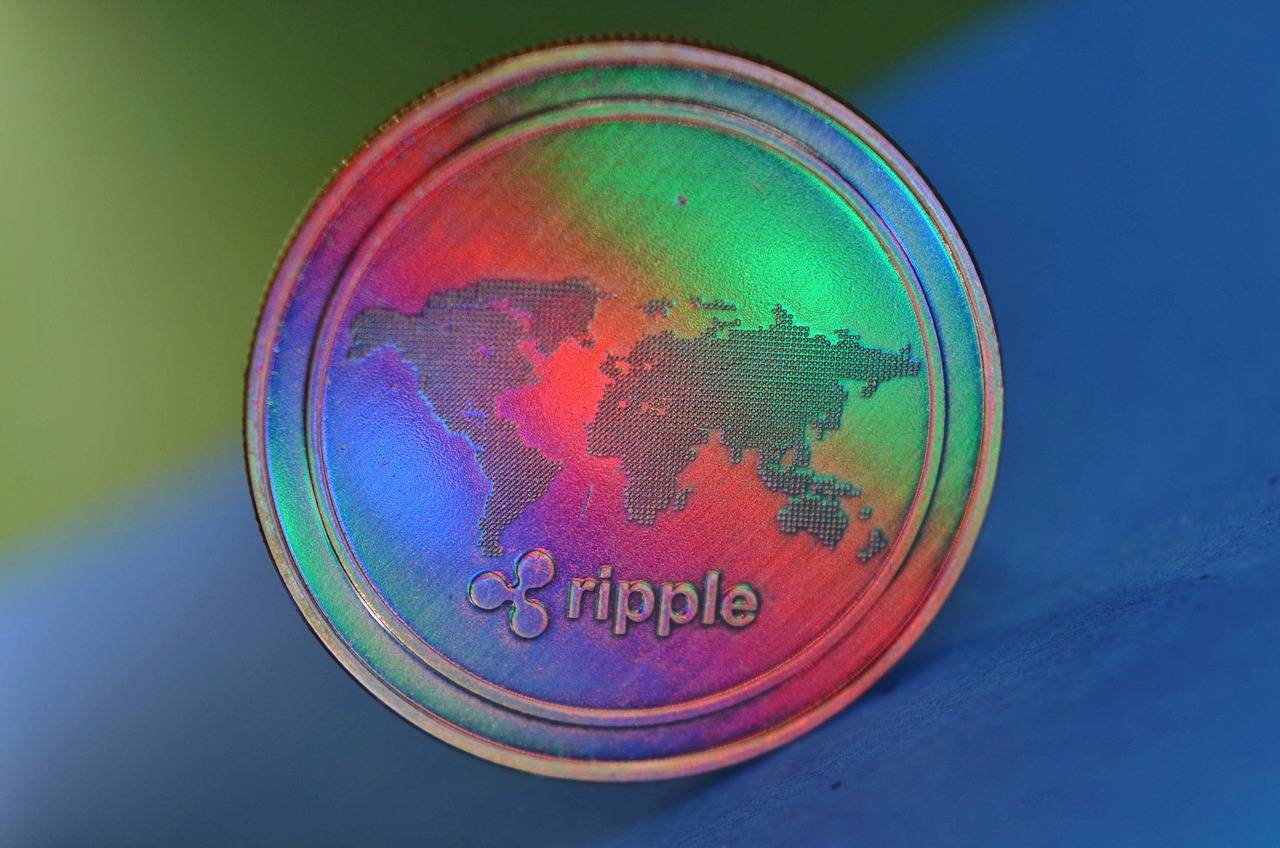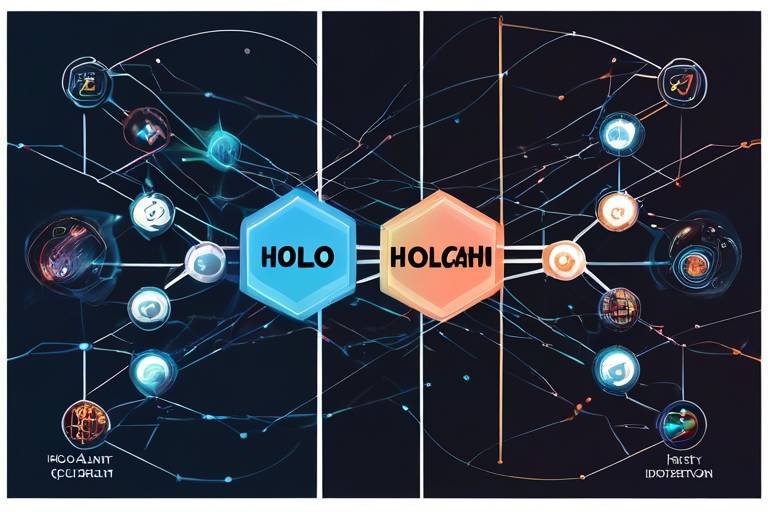0x Protocol - Enabling Decentralized Exchanges
The 0x Protocol is a game-changer in the world of decentralized finance (DeFi), acting as a bridge that connects buyers and sellers in a seamless, peer-to-peer trading environment. Imagine a marketplace where you can exchange tokens directly with others without the need for a middleman or centralized authority. That’s exactly what 0x enables. It leverages the power of blockchain technology, particularly the Ethereum network, to facilitate these transactions, ensuring that they are both secure and efficient.
At its core, the 0x Protocol is designed to enhance the trading experience by providing the necessary infrastructure for decentralized exchanges. It allows users to create, sign, and fulfill orders without ever having to trust a central entity. This means that users maintain complete control over their funds, reducing the risk of hacks and fraud that often plague centralized exchanges. With the rise of DeFi, the importance of protocols like 0x cannot be overstated, as they empower users and promote financial sovereignty.
One of the key features of the 0x Protocol is its ability to facilitate off-chain order relay. This means that while the actual trading occurs on-chain, the order books can be managed off-chain, which significantly increases the speed and efficiency of transactions. By separating the trading process into on-chain and off-chain components, 0x minimizes the gas fees associated with trading, making it more cost-effective for users. It’s like having a fast lane in a busy highway, where only the essential transactions get processed on the main road, while others can move more freely on the side.
Moreover, the 0x Protocol is designed to be interoperable, meaning it can work with various decentralized applications (dApps) and protocols. This flexibility allows developers to integrate 0x into their platforms easily, fostering a rich ecosystem of decentralized trading solutions. With the growing interest in DeFi, the potential applications of the 0x Protocol are limitless, paving the way for innovative trading solutions that cater to diverse user needs.
In summary, the 0x Protocol stands at the forefront of decentralized trading, offering a robust framework that enhances liquidity, reduces costs, and empowers users. As we dive deeper into the architecture, benefits, challenges, and future prospects of the 0x Protocol, it becomes clear that this technology is not just a passing trend; it’s a fundamental shift in how we think about trading and finance in the digital age.
- What is the 0x Protocol? - The 0x Protocol is an open-source protocol that enables peer-to-peer trading of tokens on the Ethereum blockchain without the need for a centralized intermediary.
- How does 0x Protocol work? - It operates by allowing users to create and sign orders off-chain, which are then matched and executed on-chain, ensuring security and efficiency.
- What are the benefits of using 0x Protocol? - Key benefits include reduced trading costs, increased liquidity, enhanced user experience, and improved security through decentralized trading.
- What challenges does the 0x Protocol face? - Challenges include scalability issues, regulatory concerns, and competition from other decentralized exchanges.
- What is the future of the 0x Protocol? - The future looks promising with ongoing developments, partnerships, and its potential to play a significant role in the broader DeFi ecosystem.

Understanding 0x Protocol
The 0x Protocol is a groundbreaking framework designed to facilitate seamless peer-to-peer trading of tokens on the Ethereum blockchain. Imagine a marketplace where buyers and sellers can connect directly without the need for intermediaries—this is precisely what 0x aims to achieve. By leveraging the power of smart contracts and decentralized technologies, it allows users to trade assets in a trustless environment, enhancing security and efficiency.
At its core, the 0x Protocol serves as a set of open-source standards that developers can use to build decentralized exchanges (DEXs). This flexibility means that anyone can create a trading platform that utilizes the 0x Protocol, promoting innovation within the decentralized finance (DeFi) space. One of its standout features is the ability to facilitate off-chain order relay, which reduces the congestion often seen on-chain and allows for faster transaction speeds.
Moreover, 0x is not just about trading; it’s about creating a vibrant ecosystem. By enabling various types of trading applications, from simple DEXs to complex financial instruments, it opens the door for a diverse range of use cases. The protocol supports the trading of any Ethereum-based asset, making it a versatile tool in the DeFi toolkit. This adaptability is crucial, especially as the demand for decentralized solutions continues to rise.
To better understand the significance of the 0x Protocol, consider the following key features:
- Decentralization: Eliminates the need for centralized exchanges, reducing the risk of hacks and fraud.
- Interoperability: Works seamlessly with other Ethereum-based projects, enhancing liquidity across platforms.
- Cost Efficiency: Lowers trading fees by allowing users to trade directly without intermediaries.
In essence, the 0x Protocol is not just a tool; it’s a movement towards a more decentralized financial system. As users become increasingly aware of the benefits of self-custody and direct trading, the demand for protocols like 0x will only grow. The potential for creating a more inclusive financial landscape is immense, and 0x is at the forefront of this revolution.

Architecture of 0x Protocol
The architecture of the 0x Protocol is a sophisticated blend of various components designed to facilitate seamless decentralized trading on the Ethereum blockchain. At its core, the protocol employs a combination of smart contracts, an off-chain order relay system, and a unique order matching mechanism. This innovative structure not only enhances trading efficiency but also ensures that users enjoy a secure and trustless trading environment. Imagine a bustling marketplace where buyers and sellers can interact without the need for a middleman; that’s essentially what 0x aims to achieve within the digital asset space.
One of the standout features of the 0x Protocol is its reliance on smart contracts. These self-executing contracts automate trade execution, allowing for transactions to occur without the need for third-party intervention. When a trade is initiated, the smart contracts take over, ensuring that the terms of the trade are met before finalizing the exchange of tokens. This not only streamlines the process but also builds trust among users, as they can be confident that their transactions are executed exactly as agreed upon.
Within the 0x Protocol, smart contracts play a pivotal role. They are responsible for managing the entire trading process, from order creation to execution. When a user wants to trade, they create an order and sign it with their private key. This signed order is then submitted to the network, where it can be matched with other orders. The beauty of this system lies in its ability to eliminate the need for centralized exchanges, which can often be targets for hacks and fraud. By using smart contracts, 0x ensures that trades are not only executed efficiently but also securely.
The order matching mechanism is another crucial element of the 0x architecture. When users create orders, they are signed and broadcasted to the network. The protocol allows for both limit orders and market orders, providing flexibility to traders. Once an order is created, it can be matched with other orders in the system. This decentralized matching process is facilitated by relayers, who play an essential role in ensuring that orders are visible to potential counterparties. The efficiency of this mechanism is what makes the 0x Protocol stand out from traditional exchanges, where order matching can often be slow and cumbersome.
Relayers are a fundamental part of the 0x ecosystem. They act as intermediaries that facilitate the broadcasting of orders to the network. By providing a platform for users to submit their orders, relayers help create a vibrant trading environment. In return for their services, relayers earn fees, which can vary based on the volume of trades they facilitate. This fee structure incentivizes relayers to maintain high levels of service and helps to ensure that the marketplace remains active and competitive. Think of relayers as the shopkeepers in our marketplace analogy, who help connect buyers and sellers while ensuring that the trading environment remains lively.
In summary, the architecture of the 0x Protocol is a carefully crafted system that combines smart contracts, an innovative order matching mechanism, and the vital role of relayers to create a decentralized trading platform that is efficient, secure, and user-friendly. As the blockchain ecosystem continues to evolve, the 0x Protocol stands at the forefront of decentralized exchanges, paving the way for a new era of trading.
- What is the 0x Protocol? The 0x Protocol is an open-source protocol that enables the peer-to-peer exchange of tokens on the Ethereum blockchain.
- How do smart contracts work in the 0x Protocol? Smart contracts automate trade execution, ensuring that transactions are conducted securely and without the need for intermediaries.
- What role do relayers play? Relayers facilitate the broadcasting of orders and earn fees for their services, helping to create a dynamic trading environment.
- What are the benefits of using 0x Protocol? The protocol offers reduced trading costs, increased liquidity, and an improved user experience compared to traditional exchanges.

Smart Contracts in 0x
The 0x Protocol leverages the power of smart contracts to revolutionize the way we think about trading tokens on the Ethereum blockchain. But what exactly are smart contracts, and why are they so crucial to the 0x ecosystem? In essence, smart contracts are self-executing contracts with the terms of the agreement directly written into code. They run on the blockchain, which means they are immutable and transparent, ensuring that all parties involved can trust the system without needing a middleman. This is particularly important in decentralized exchanges (DEXs), where trust is a fundamental concern.
Within the 0x Protocol, smart contracts play several pivotal roles. Firstly, they automate the trade execution process. Imagine you’re at a bustling marketplace where everyone is shouting their prices. Now, picture a quiet corner where a digital assistant records your offers and automatically completes the trade when the right conditions are met. That’s what smart contracts do! They ensure that trades are executed only when both parties have fulfilled their obligations, thus minimizing the risk of fraud or default.
Furthermore, the use of smart contracts in the 0x Protocol allows for trustless transactions. This means that users do not need to trust each other; they only need to trust the code. The smart contracts handle the entire transaction process, from order creation to execution, and they do so without requiring any human intervention. This level of automation not only speeds up the trading process but also significantly reduces costs associated with traditional trading platforms.
Additionally, smart contracts in the 0x Protocol enable the creation of customizable trading conditions. Traders can set specific parameters for their trades, such as expiration times and price limits, all of which are coded into the smart contract. This flexibility empowers users to define their trading strategies clearly and execute them without fear of external manipulation.
To summarize, the significance of smart contracts in the 0x Protocol can be distilled into several key benefits:
- Automation: Facilitates seamless trade execution without manual intervention.
- Trustlessness: Eliminates the need for trust between parties, relying instead on code.
- Cost Efficiency: Reduces transaction costs compared to traditional exchanges.
- Customizability: Offers traders the ability to set personalized trading conditions.
In conclusion, smart contracts are the backbone of the 0x Protocol, enabling a new era of decentralized trading that is not only efficient but also secure and user-friendly. As the blockchain ecosystem continues to evolve, the role of these digital contracts will only become more pronounced, paving the way for innovative trading solutions that prioritize user empowerment and trust.

Order Matching Mechanism
The in the 0x Protocol is a fascinating process that ensures efficient and effective trading in a decentralized environment. Imagine a bustling marketplace where buyers and sellers are constantly looking for the best deal; this is essentially what happens in the world of decentralized exchanges (DEX) powered by 0x. The protocol facilitates the creation, signing, and matching of orders, which are essential for executing trades without the need for a centralized authority.
At the heart of this mechanism is the concept of off-chain order relay. Orders are created by users and then broadcast to relayers, who act as intermediaries. These relayers help match buy and sell orders while keeping the actual trading process secure and efficient. When a user places an order, it is signed using their private key, ensuring that only the owner can authorize the transaction. This cryptographic signing is akin to placing a unique stamp on a document, confirming its authenticity and ownership.
Once the orders are signed, they are sent to relayers, which can be thought of as the "postmen" of the 0x ecosystem. These relayers collect orders from various users and publish them on their platforms, allowing other users to see available trading opportunities. The beauty of this system lies in its decentralization; there is no single point of failure, and users can choose from a variety of relayers based on their preferences for speed, fees, or user experience.
When a buyer and a seller find matching orders, the protocol kicks in to execute the trade. This is where smart contracts come into play, automating the entire process. The smart contract ensures that the terms of the trade are met before the actual transfer of tokens occurs. Think of it like a trusted third party that holds onto the goods until both parties fulfill their obligations. This trustless execution is one of the key advantages of using the 0x Protocol.
To illustrate how this order matching works, consider the following simplified flow:
| Step | Description |
|---|---|
| 1 | User A creates a buy order and signs it. |
| 2 | User A sends the order to a relayer. |
| 3 | User B creates a sell order that matches User A's buy order. |
| 4 | The relayer matches the orders and notifies both users. |
| 5 | A smart contract executes the trade, transferring tokens between users. |
This process is not only efficient but also enhances liquidity in the market. By allowing multiple relayers to operate simultaneously, the 0x Protocol can facilitate a large volume of trades without bottlenecks. However, challenges remain, such as ensuring that relayers remain reliable and competitive. The future of the order matching mechanism will likely involve improvements in technology and user experience, making decentralized trading even more accessible and appealing.
- What is the role of relayers in the 0x Protocol? Relayers facilitate the broadcasting of orders and help match buyers with sellers, earning fees for their services.
- How does the 0x Protocol ensure trustless transactions? Through the use of smart contracts, which automate trade execution and ensure that both parties meet their obligations before the trade is finalized.
- Can anyone become a relayer? Yes, anyone can set up a relayer to broadcast orders and earn fees, contributing to the decentralized nature of the protocol.

Relayers and Their Function
The role of relayers in the 0x Protocol is akin to that of a bridge in a bustling city, facilitating the smooth flow of traffic between two points. In the world of decentralized exchanges (DEXs), relayers serve as crucial intermediaries that enable users to broadcast their orders without having to directly interact with the blockchain for every transaction. This off-chain order relay mechanism not only enhances the overall trading experience but also significantly reduces the costs associated with on-chain transactions.
When a user wants to trade tokens, they create an order and send it to a relayer. This relayer then lists the order on their platform, making it visible to other traders. The beauty of this system lies in its decentralization; unlike traditional exchanges where a central authority manages order books, relayers operate independently. They earn fees through a variety of models, often taking a small percentage of the transaction value or charging a flat fee per order. This incentivizes relayers to maintain a high level of service, ensuring that orders are matched efficiently and effectively.
Furthermore, relayers play a pivotal role in maintaining the liquidity of the 0x ecosystem. By aggregating orders from various users, they create a more dynamic and robust trading environment. The more orders a relayer can gather, the better the chances of matching buyers and sellers, which ultimately leads to tighter spreads and more favorable prices for traders. This is especially important in the volatile world of cryptocurrency, where price discrepancies can arise rapidly.
One of the challenges relayers face, however, is the need to attract users to their platforms. With numerous relayers available, competition can be fierce. To stand out, many relayers offer unique features, such as advanced trading tools, user-friendly interfaces, and enhanced security measures. Some even provide additional services like analytics and market insights, which can significantly enhance the trading experience for users.
In summary, relayers are essential to the functionality of the 0x Protocol, acting as facilitators that enhance the trading experience by providing liquidity, reducing costs, and ensuring efficient order matching. As the decentralized finance (DeFi) space continues to evolve, the role of relayers may become even more prominent, paving the way for innovative trading solutions that cater to the needs of a diverse user base.
- What is a relayer in the 0x Protocol? A relayer is an intermediary that facilitates the broadcasting of orders in the 0x Protocol, allowing users to trade tokens efficiently without directly interacting with the blockchain.
- How do relayers earn fees? Relayers typically earn fees by charging a percentage of the transaction value or a flat fee per order, incentivizing them to provide high-quality services.
- Why are relayers important for liquidity? By aggregating orders from multiple users, relayers create a more dynamic trading environment, improving the chances of matching buyers and sellers and resulting in better prices.
- What challenges do relayers face? Relayers must compete with one another to attract users, often requiring them to offer unique features or services to stand out in a crowded marketplace.

Benefits of Using 0x Protocol
The 0x Protocol is revolutionizing the way we think about trading in the decentralized finance (DeFi) space. One of the most compelling benefits of using this protocol is the significant reduction in trading costs. Unlike traditional exchanges that often impose hefty fees, 0x allows users to trade directly with one another, eliminating the need for intermediaries. This peer-to-peer model not only saves money but also enhances the overall trading experience.
Moreover, the liquidity provided by the 0x Protocol is another major advantage. By allowing multiple decentralized exchanges to tap into a shared liquidity pool, users can benefit from better prices and lower slippage. This interconnectedness means that traders can execute orders more efficiently, which is a game-changer in the fast-paced world of crypto trading.
Another important feature of the 0x Protocol is its ability to support a wide variety of tokens. This flexibility enables users to trade an extensive range of digital assets without being restricted to a single platform. In fact, the protocol is designed to facilitate the trading of any ERC20 token, making it a versatile tool for both developers and traders alike.
Additionally, the user experience offered by the 0x Protocol is vastly improved compared to traditional exchanges. The protocol's architecture allows for seamless integration with various wallets and applications, making it easier for users to manage their assets and execute trades. Imagine being able to trade directly from your favorite wallet without having to navigate through complicated interfaces—this is the kind of convenience that 0x brings to the table.
To summarize, the benefits of using the 0x Protocol can be categorized as follows:
- Reduced Trading Costs: Lower fees compared to traditional exchanges.
- Increased Liquidity: Access to shared liquidity pools across multiple platforms.
- Token Versatility: Support for a wide range of ERC20 tokens.
- Enhanced User Experience: Seamless integration with wallets and applications.
In conclusion, the 0x Protocol is not just another player in the DeFi ecosystem; it is a robust solution that addresses some of the most pressing challenges faced by traders. By enabling cost-effective, liquid, and user-friendly trading experiences, 0x is paving the way for a more decentralized future.
1. What is the 0x Protocol?
The 0x Protocol is an open-source protocol that facilitates peer-to-peer trading of tokens on the Ethereum blockchain, allowing users to trade directly with one another without the need for intermediaries.
2. How does the 0x Protocol reduce trading costs?
By eliminating intermediaries, the 0x Protocol allows users to trade directly, which significantly lowers the transaction fees typically associated with traditional exchanges.
3. What types of tokens can be traded using 0x?
The 0x Protocol supports any ERC20 token, giving users the flexibility to trade a wide variety of digital assets.
4. How does 0x improve liquidity?
The protocol connects multiple decentralized exchanges, allowing them to share liquidity pools, which results in better prices and reduced slippage for traders.
5. Is the 0x Protocol user-friendly?
Yes, the 0x Protocol is designed for seamless integration with various wallets and applications, making it easier for users to manage their assets and execute trades.

Challenges Facing 0x Protocol
The 0x Protocol, while revolutionary in the realm of decentralized exchanges (DEXs), is not without its challenges. As the blockchain landscape continues to evolve, the protocol faces several obstacles that could impede its growth and adoption. Understanding these challenges is crucial for developers, investors, and users alike, as they navigate the complexities of decentralized finance (DeFi). So, what are these hurdles that the 0x Protocol must overcome?
One of the most pressing issues is scalability. As more users flock to DEXs, the demand for efficient and speedy transactions surges. The Ethereum blockchain, which underpins the 0x Protocol, has faced significant congestion, leading to increased transaction fees and slower processing times. Imagine trying to catch a train during rush hour; the platform is overcrowded, and the trains are delayed. This scenario is akin to what users experience when the network is overwhelmed. The 0x team is actively exploring layer 2 solutions and sidechains to enhance scalability and improve user experience.
Another challenge is the regulatory landscape. As governments around the world begin to scrutinize cryptocurrencies and decentralized platforms, the 0x Protocol finds itself in a precarious position. Regulatory uncertainty can stifle innovation and deter users from engaging with DEXs. The protocol must navigate these waters carefully, ensuring compliance while still promoting the core principles of decentralization and user autonomy. It's like walking a tightrope; one misstep could lead to significant consequences.
Moreover, the 0x Protocol faces stiff competition from other decentralized exchange solutions. Platforms like Uniswap and SushiSwap have made significant strides in attracting users with their unique features and liquidity incentives. This competition can dilute the user base and create challenges in maintaining liquidity on the 0x Protocol. To stay relevant, 0x must continually innovate and offer compelling reasons for users to choose its platform over others.
In addition to these factors, the user experience remains a critical area for improvement. While the protocol provides a framework for peer-to-peer trading, the overall user interface and experience can be daunting for newcomers to the crypto space. If users find it challenging to navigate the platform, they may abandon it in favor of more intuitive alternatives. Enhancing the user experience is essential for driving adoption and ensuring long-term success.
In conclusion, the challenges facing the 0x Protocol are multifaceted, ranging from scalability and regulatory concerns to competition and user experience. However, with the right strategies and innovations, these hurdles can be overcome. As the DeFi ecosystem continues to mature, the 0x Protocol has the potential to solidify its place as a leading solution for decentralized trading, provided it adapts and evolves in response to these challenges.
- What is the 0x Protocol? The 0x Protocol is an open-source protocol that enables peer-to-peer trading of tokens on the Ethereum blockchain.
- How does the 0x Protocol ensure trustless transactions? The protocol uses smart contracts to automate trade execution, ensuring that transactions are executed without the need for intermediaries.
- What are relayers in the 0x ecosystem? Relayers are entities that facilitate order broadcasting and earn fees for their services, playing a crucial role in the order matching process.
- What are the main challenges facing the 0x Protocol? The main challenges include scalability issues, regulatory concerns, competition from other DEXs, and the need for improved user experience.

Scalability Issues
The 0x Protocol has made significant strides in enabling decentralized exchanges, but it is not without its challenges, particularly when it comes to scalability. As the demand for decentralized trading solutions grows, the 0x Protocol faces the daunting task of managing an increasing volume of transactions without compromising speed or efficiency. Imagine trying to serve a growing crowd at a popular food truck—if the line gets too long, customers will lose patience and seek alternatives. This analogy perfectly illustrates the scalability issues 0x is grappling with.
One primary concern is the reliance on the Ethereum blockchain, which, while revolutionary, has its limitations. During periods of high demand, the Ethereum network can become congested, leading to slower transaction times and increased gas fees. This situation can deter users from utilizing decentralized exchanges built on the 0x Protocol, as they may find the costs prohibitive and the waiting time frustrating. To illustrate this point, let's take a look at some statistics:
| Year | Average Gas Price (Gwei) | Average Transaction Time (seconds) |
|---|---|---|
| 2021 | 100 | 30 |
| 2022 | 200 | 60 |
| 2023 | 150 | 45 |
These figures highlight the volatility in gas prices and transaction times, which can fluctuate wildly based on network usage. As a result, the 0x Protocol must find innovative solutions to enhance its scalability. One potential avenue is the implementation of layer 2 solutions, such as zk-Rollups or Optimistic Rollups, which allow for faster transactions by processing them off-chain before settling on the Ethereum mainnet. This approach can significantly reduce congestion and costs, making decentralized trading more appealing.
Moreover, the 0x Protocol could benefit from optimizing its smart contracts to ensure they are as efficient as possible. By minimizing the computational resources required for transactions, it can alleviate some of the pressure on the Ethereum network. However, this requires ongoing development and collaboration within the community to identify best practices and implement them effectively.
In conclusion, while the scalability issues facing the 0x Protocol are significant, they are not insurmountable. With the right strategies and technological advancements, 0x can enhance its capacity to handle larger transaction volumes, thereby improving the overall user experience. The future of decentralized exchanges depends on how well protocols like 0x can adapt to these challenges and continue to innovate in a rapidly evolving blockchain landscape.
- What is the 0x Protocol? The 0x Protocol is an open-source protocol that enables peer-to-peer trading of tokens on the Ethereum blockchain, facilitating decentralized exchanges.
- How does 0x address scalability issues? 0x can utilize layer 2 solutions and optimize its smart contracts to improve transaction speeds and reduce costs.
- What are relayers in the 0x ecosystem? Relayers are entities that facilitate order broadcasting and earn fees for their services, playing a crucial role in the 0x Protocol's functionality.

Regulatory Considerations
This article explores the 0x Protocol, its architecture, advantages, and impact on decentralized exchanges, along with its challenges and future prospects in the blockchain ecosystem.
An overview of the 0x Protocol, including its purpose, key features, and how it facilitates peer-to-peer trading of tokens on the Ethereum blockchain.
A detailed look at the technical structure of the 0x Protocol, focusing on its smart contracts, off-chain order relay, and how these components work together to enhance trading efficiency.
Exploration of the role of smart contracts in the 0x Protocol, detailing how they automate trade execution and ensure trustless transactions between parties.
An examination of the order matching process within the 0x Protocol, including how orders are created, signed, and matched in a decentralized environment.
A discussion on the role of relayers in the 0x ecosystem, highlighting how they facilitate order broadcasting and earn fees for their services.
An analysis of the advantages offered by the 0x Protocol, such as reduced trading costs, increased liquidity, and improved user experience in decentralized trading.
An overview of the current challenges and limitations of the 0x Protocol, including scalability issues, regulatory concerns, and competition from other decentralized exchange solutions.
A closer look at the scalability challenges faced by the 0x Protocol, discussing potential solutions and the impact on user adoption and trading volume.
The regulatory landscape surrounding decentralized exchanges is as complex as a labyrinth, with each turn presenting new challenges and considerations. As the 0x Protocol operates in a space that is often viewed through a scrutinizing lens by regulators, understanding these dynamics is crucial. Regulatory compliance can significantly impact the operation and growth of decentralized exchanges.
One of the primary concerns is the classification of tokens and how they are viewed under existing laws. Are they securities? Are they commodities? This uncertainty can lead to increased scrutiny from regulatory bodies, which can stifle innovation and deter users from participating in the ecosystem. Additionally, the need for anti-money laundering (AML) and know your customer (KYC) regulations poses another layer of complexity. Decentralized platforms like 0x must navigate these regulations carefully to avoid hefty fines or shutdowns.
Furthermore, as governments worldwide begin to draft legislation regarding cryptocurrencies, the 0x Protocol faces the challenge of adapting to a rapidly changing regulatory environment. The following table outlines some key regulatory considerations:
| Regulatory Aspect | Description |
|---|---|
| Token Classification | Determining whether tokens are securities or commodities affects how they are regulated. |
| AML/KYC Compliance | Decentralized exchanges may need to implement measures to prevent money laundering and verify user identities. |
| Tax Implications | Understanding how transactions are taxed can impact user participation and reporting requirements. |
| Global Regulatory Differences | Different countries have varying regulations, making it challenging for a global platform like 0x. |
In essence, the regulatory considerations for the 0x Protocol are not just hurdles but also opportunities for shaping the future of decentralized finance. By proactively engaging with regulators and adhering to best practices, the 0x Protocol can help pave the way for a more stable and secure decentralized trading environment.
Insights into the future trajectory of the 0x Protocol, including upcoming developments, partnerships, and its potential role in the broader decentralized finance (DeFi) ecosystem.
- What is the 0x Protocol? The 0x Protocol is a decentralized exchange protocol that enables peer-to-peer trading of tokens on the Ethereum blockchain.
- How does the 0x Protocol ensure security? The protocol uses smart contracts to automate trade execution and ensure trustless transactions between parties.
- What are the benefits of using 0x Protocol? Benefits include reduced trading costs, increased liquidity, and an improved user experience.
- What challenges does the 0x Protocol face? Key challenges include scalability issues, regulatory concerns, and competition from other decentralized exchanges.

The Future of 0x Protocol
The future of the 0x Protocol is as exciting as it is uncertain. As the landscape of decentralized finance (DeFi) continues to evolve, 0x stands at the forefront, ready to adapt and innovate. With its unique architecture and community-driven approach, the protocol is well-positioned to tackle the challenges that lie ahead. But what exactly does the future hold for 0x? Let's dive into some of the upcoming developments, potential partnerships, and its role in the ever-expanding DeFi ecosystem.
One of the most significant aspects of the future of 0x is its commitment to continuous improvement. The team behind the protocol is actively working on enhancing its features and functionality. For instance, they are exploring the integration of Layer 2 solutions, which could dramatically increase transaction speeds and reduce costs. Imagine being able to trade tokens almost instantaneously without the hefty gas fees that currently plague the Ethereum network. This could open the floodgates for more users, making decentralized trading a feasible option for everyone.
Moreover, 0x is not just sitting idle; it is forging partnerships with various projects within the DeFi space. These collaborations are crucial as they can lead to greater liquidity and a more robust trading environment. By joining forces with other platforms, 0x can leverage their strengths, creating a powerful ecosystem that benefits all participants. Think of it like a band coming together to create a symphony—each musician brings their unique sound, and together, they create something beautiful.
In addition to partnerships, the future of 0x Protocol also hinges on its community. The 0x community is vibrant and engaged, and its input is invaluable for the protocol's evolution. The team actively seeks feedback and suggestions, ensuring that the protocol evolves in a way that meets the needs of its users. This decentralized governance model not only empowers users but also fosters a sense of ownership and belonging within the ecosystem.
However, the road ahead is not without its bumps. The regulatory landscape surrounding decentralized exchanges is still murky, and as governments around the world grapple with how to regulate cryptocurrencies and DeFi, 0x must navigate these waters carefully. Staying compliant while maintaining its core values of decentralization and user empowerment will be a delicate balancing act. It's like walking a tightrope—one misstep could lead to significant repercussions.
So, what does all this mean for the average user? As 0x continues to innovate and adapt, users can expect a more seamless trading experience, reduced costs, and increased access to a wider variety of tokens. The future of trading is decentralized, and 0x is leading the charge. With its commitment to improving the protocol and fostering a strong community, the 0x Protocol is not just a fleeting trend; it is a cornerstone of the future financial landscape.
- What is the 0x Protocol?
The 0x Protocol is an open-source protocol that enables peer-to-peer trading of tokens on the Ethereum blockchain, facilitating decentralized exchanges. - How does 0x Protocol ensure trustless transactions?
Through the use of smart contracts, the 0x Protocol automates trade execution, ensuring that transactions are executed fairly and securely without the need for intermediaries. - What are the benefits of using 0x Protocol?
Some benefits include reduced trading costs, increased liquidity, and an improved user experience in decentralized trading. - What challenges does 0x Protocol face?
The protocol faces scalability issues, regulatory concerns, and competition from other decentralized exchange solutions. - What is the future outlook for the 0x Protocol?
The future looks promising, with ongoing developments, potential partnerships, and a strong community driving its evolution in the DeFi ecosystem.
Frequently Asked Questions
- What is the 0x Protocol?
The 0x Protocol is an open-source protocol that facilitates peer-to-peer trading of tokens on the Ethereum blockchain. It enables decentralized exchanges to operate more efficiently by allowing users to trade directly without the need for a centralized intermediary.
- How does the 0x Protocol work?
The 0x Protocol works by utilizing smart contracts and an off-chain order relay system. Users create orders that are signed and broadcasted via relayers, which match buy and sell orders in a decentralized manner, ensuring that trades are executed trustlessly.
- What are the benefits of using the 0x Protocol?
Some key benefits of the 0x Protocol include reduced trading costs, increased liquidity, and an improved user experience. By allowing for direct token swaps, it minimizes the fees typically associated with centralized exchanges.
- What challenges does the 0x Protocol face?
The 0x Protocol faces several challenges, including scalability issues, regulatory concerns, and competition from other decentralized exchange solutions. These factors can impact user adoption and overall trading volume.
- What is the role of relayers in the 0x ecosystem?
Relayers are crucial to the 0x ecosystem as they facilitate the broadcasting of orders and earn fees for their services. They act as intermediaries that help match buyers and sellers while ensuring the efficiency of the trading process.
- How does the 0x Protocol ensure trustless transactions?
The 0x Protocol ensures trustless transactions through the use of smart contracts. These contracts automatically execute trades when conditions are met, eliminating the need for trust between parties and enhancing security.
- What is the future of the 0x Protocol?
The future of the 0x Protocol looks promising, with ongoing developments and potential partnerships that aim to enhance its functionality and integration within the broader decentralized finance (DeFi) ecosystem.



















